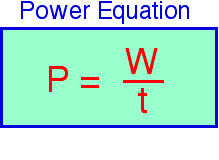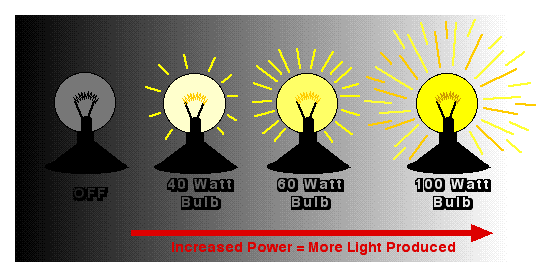 |
Middle School Home Energy AuditPOWER |
 |
|
|
|
|
|
 |
Middle School Home Energy AuditPOWER |
 |
|
|
|
|
|
- What is power?
- How is power related to work?
- When we buy power from the electric utility company, how is it measured?
Power
Work can be done at different rates. Since work involves the transfer of energy, the faster work is done, the quicker energy needs to be transferred. Power is the measure of how fast work can be done. In other words, power is that it is the rate at which energy is transferred.
Let's take the example of carrying a box of school books up a set of stairs. From experience, we know that running the books up the stairs takes more energy than walking the same distance (you would be more tired if you ran). But the amount of work done is the same since the books weighed the same and moved the same distance each trip. However, the work is done much faster if we run, so energy must be converted faster. Therefore, more power is required.
These same principles apply to mechanical devices. Think of a race car verses an economy car. They both can travel the same distance, but the race car does it much faster since it is capable of expending much more energy in much less time. This is because the more powerful car can convert energy quicker.
Mathematically, power is determined by dividing the amount of work (W) by the time (t) required to accomplish the task. Joules per second equal watts.

Electrical Power
When dealing with electricity, power is defined in the same way. Electrical devices provide resistance which describes the amount of work that needs to be done for a specific task. A certain amount of work must be done to move electrons through the resistance. More resistance means more work must be done to move electrons through the resistance and allow the device to operate. The rate at which that work is accomplished is related to the power applied. More electrical power means more energy is being converted. This electrical energy is supplied by the source of the electrical current, like a battery or electrical generator.
Power is measured in units called watts (W) which are equal to the number of joules of energy expended per second. This means that energy can be expended at different rates depending on how fast the work needs to be done. Some devices use lots of power to accomplish a task (these are generally refered to as "powerful") while others use much less.
So how does electrical power affect you? Maybe you have noticed that lightbulbs come in different "sizes." Some lightbulbs are rated at 60 watts while others are rated at 100 watts. Which one do you think would give off more light (be brighter)? Since a 100 watt lightbulb uses more energy (measured in watts) in a given time, it would give off more light during that given time as long as all other factors are the same. In your home, you would have to decide exactly how much light you really need in a particular area when selecting a bulb. If you need more light, you would use a bulb that is rated at a higher power. Always remember, though, that for more light, you need more power which means a higher cost to operate!
The tradeoff between using conserving energy and getting the performance we need from our electrical devices is one to always keep in mind. By using more electrical power, our tools and appliances can do more, but at a greater cost to us. In fact, one consequence of high electrical power usage today could be black outs--a total loss of power in an area!

Buying Electrical Power
Electrical energy is supplied by the source of the electrical current such as a battery or electrical generator. In most homes, this energy is purchased from a power company that may have several large electrical generating plants. The electrical energy travels through power lines to individual homes to be sold to the homeowner. The units of energy sold is represented in units of 1000 watts delivered for one hour, or units called kilowatt-hours.
The more electrical power a consumer demands, the more kilowatts are used. The rate of this usage is measured over time. So, the more time you demand power, the more kilowatt-hours you would use, and the more you would have to pay to the utility company for generating your electricity.
1 kilowatt = 1000 watts 1 kilowatt-hour = 1000 watts delivered for 1 hour Recently, some areas of the country have been forced into "rolling blackouts" and other extreme measures to maintain electrical power throughout the power network. These measures are directly linked to high power demand from consumers coupled with a low supply of power. In these cases, electrical power is turned off to sections of service to conserve power so that the entire grid does not lose power alltogether. If there is not enough power available to perform the work that it is being asked to do at the rate needed, electrical devices will stop working. What are some possible solutions to this situation?
Did you see a word or two that you did not recognize? You might find it in the glossary below.
|
|
|
|
|
|
|
|
|
|
|
|
|
|
|
|
|
|
|
|
|
|
|
|
|
|
|
|
|
|
|
|
Authors: Sue Emmons, Powell Midddle School, Littleton, CO; Kevin Lindauer, Baker Middle School, Denver, CO; Janet Stellema, Monarch K-8, Louisville, CO; John Sepich, Scott Carpenter Middle School, Westminster, CO; Edited by Marge Bardeen NTEP II Project PI.
Webmaster: ed-webmaster@fnal.gov
Created: September 9, 1998 revised July 30, 2001
URL: /ntep/f8/projects/nrel/student/power.html